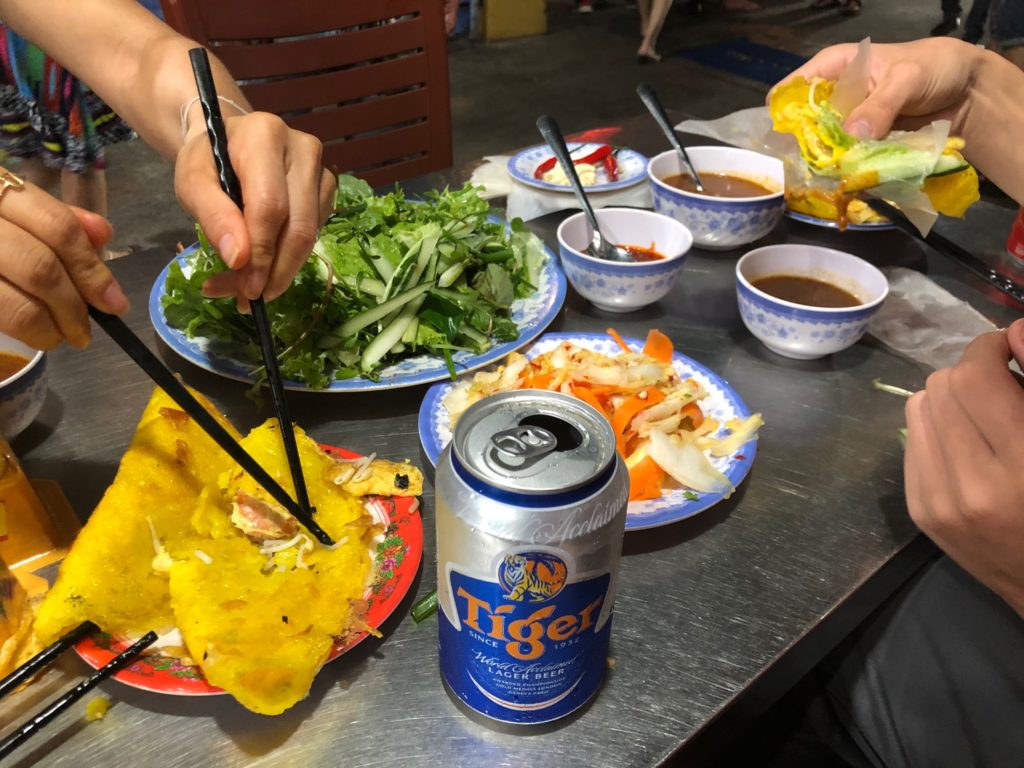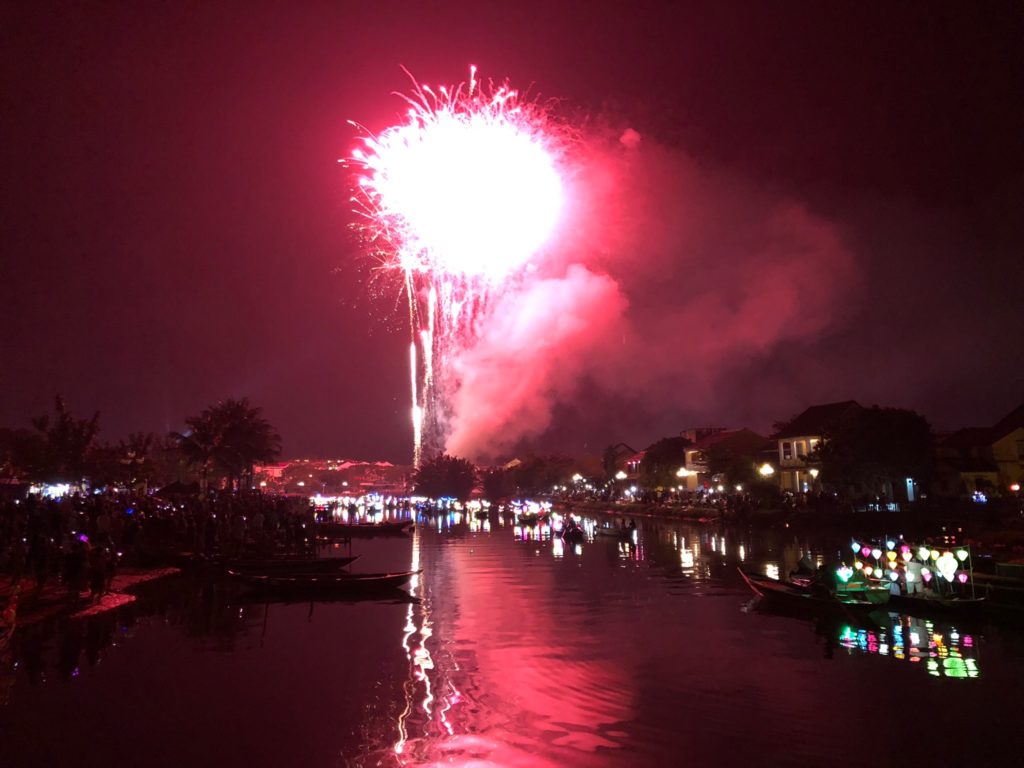Hoi An is (was?) a quaint fishing village located at the mouth of the Thu Bon river. In historic times (around 1000 years ago) it was an important port for the Cham people who controlled the spice trade in the region. It later became a local center for the production of rice and silk. It’s combination of location and natural wealth brought prosperity to the town. It went unscathed from the conflicts of the 20th century and entered the 21st century retaining its historic charm and character.
In 1999 the Old Town of Hoi An was made a UNESCO World Heritage Site and tourists began to wander its streets in larger numbers. Tales of its romantic charm began to spread. I’ve heard from other travelers that as recently as 2010 it was still “undiscovered” with no tourist infrastructure. That has now changed…
Hoi An stil retains its historic charm but most of the old town has been converted to a tourist bazaar for food, crafts and trinkets. The menus are multilingual and the prices are high. There is still tons of street food catering to both locals and tourists where you can get local Cao Lau or a Bahn Mi for 30,000 VND ($1.50 USD). The Central Market is (still) charming and original, catering to the local restaurants and merchants. Beyond the old town lies flooded rice paddies but development is starting to encroach in areas. Tucked into these fields and islands lie traditional homes and many tourist activities: traditional rice and vegetable farming, and many cooking schools. You can ride in traditional bamboo wicker boats and throw a fishing net.

Nearby is 20 km of white sandy beaches that stretch north to Da Nang, which has become a modern metropolis with a well equipped airport. This place has all the ingredients to make it a major vacation destination: sun, beaches, charm; and it is well on its way. In the last decade resorts have sprung up on the beach road connecting Da Nang and Hoi An (Four Seasons anyone?) with many more under construction. Da Nang is to Asia what Puerto Vallarta is to North America.
I came to Hoi An in May 2018 and loved the vibe so much that I brought the family back in Feb 2019 as part of our Southeast Asia tour. We didn’t consciously schedule our stay to coincide with the Lunar New Year, it just worked out that way. We flew in at 9pm on “New Years Eve” and our five day stay overlapped with the Tet holiday. We got to see the impressive fireworks display but the market and most of the restaurants were closed. They slowly opened back up over the week but the market remained shut, so food ingredients were scarce and the restaurants would regularly close early once they ran out of food. The tourist operators kept going because it was their high season. Every afternoon during our stay the streets filled to capacity with Vietnamese, Chinese and Korean tourists, plus a healthy mix of Westerners. There were more Koreans than I remembered, which is due to a strengthening bond between the countries.

Where to stay: You want to stay within walking distance of the old town if you can. We stayed at the Hoi An Historic Hotel which has great amenities and is perfectly situated. Rooms are around $65 USD, which is great value by western standards. They provide a nice complementary breakfast, have a great pool and spa, and have free bicycles you can use to explore beyond the old town. They also have a free shuttle to their sister hotel located at the An Bang Beach (we rode out there on our bikes so never used it).
What to do: We had four non-travel days in Hoi An and could have easily shortened it to three. Spend the first day exploring the Old Town and getting your bearings. Start by going to the Market (the best action is always early at Asian markets) and then working your way along the waterfront (if you are facing the water – go right) to the Japanese Bridge. No matter what you do during the day, head back into the Old Quarter at night, which is aglow from the light of the famous Hoi An lanterns. For the remaining days, try the following:
Get Lost in the Back Alleys: Every main street in Hoi An has been converted to a storefront and the streets are choked with people and honking mopeds. Snaking off these streets are many small alleys and walkways which lead into tranquil courtyards where the locals eat and live. It’s amazing how quiet they are given the din just a few meters away. Here you will find a different side to Hoi An and some interesting food options. Remember: not all who wander are lost…
Rent Bikes and Explore the City: We recommend you borrow or rent a bike and ride around the old city in the morning. Ride to the market, then across the bridge to the island, which can be circumnavigated in 30 minutes (or less). Then head back into the center of old town and grab lunch. Consider a Ca Phe Sua (Vietnamese coffee) before exploring the the rice fields or islands to the east or north east. Continue until you hit the ocean and chillax at a beach cafe for an hour before riding home.

Cooking Class: There are many options for half day cooking classes where you learn to make local dishes. Some combine farming or a boat ride. We went to Thuan Tinh Island and had a great time. We would have gone to the Morning Glory Restaurant cooking class but it was closed over the holiday.

Boat Ride: You will be taken to ride in a traditional “wicker basket boat”. These water craft are all over Vietnam and as an engineer and someone who spends a lot of time on the water I found them fascinating in their design and simplicity. Strips of bamboo are used to weave a basket that is about 1.2 meters (4 ft) in diameter. It is covered in tar (or fiberglass resin in modern times) to make them water tight. You will be rowed around by a wonderful old man or woman through palm lined water alleys carved into the river delta.
Fishing: This is a popular attraction but personally I didn’t find it all that exciting. The river is polluted and has been severely over fished so this is more about participating in the act of traditional fishing. You will throw a traditional fishing net and catch nothing. It’s a good photo op but low on the “authentic experience” meter. If you can combine fishing and a boat ride then its a good afternoon.
Where and What to Eat: There is lots of tourist fare in the Hoi An Old Town. We prefer to eat with the locals (well at least I do…). Hoi An classics are Cau Lao, Banh Xeo (Hoi An pancakes), White Rose and Banh Mi. Here are some places to check out:
Street Food: Like most places in Southeast Asia, street food is everywhere. Cau Lao is the local specialty and it can be found everywhere, especially around the market. Cau Lao is a combination of thicker dry noodles served with pork and green and a small amount of tasty broth. It’s flavor and texture are unique in Vietnam.

Bahn Mi: Anthony Bourdain claimed that Hoi An has some of the best Bahn Mi on the planet. Banh Mi Phuong is located on Phan Chu Trinh (that’s a road) and is famous for his patronage. I ate there in 2018 but they were closed during the Tet. We ate at Phi Banh Mi and they were great.

Morning Glory: This popular restaurant is near the main bridges in the old quarter. It’s so popular that there is the Morning Glory (original) and Morning Glory II restaurants. The menu is full of local dishes and the quality is good. There’s also lots of vegetarian options – recommend the fried egg plant. The Chef Ms Vy also has a popular cooking class (which is not offered over the Tet holiday).
Pho Xua: This restaurant stayed open during the Tet and had more business than they could handle, closing early due to food shortages. They serve a great menu of affordable local dishes. We enjoyed their Banh Xeo and White Rose. You can also get bowls of classic Pho and other Vietnamese dishes.
White Sail: This is a local’s seafood restaurant and you won’t find many westerners there, nor a lot of English. Go with a local if you can – that’s how we know of it. You have to walk down the alley leading to the right from the main intersection. The restaurant is simple and one wall is lined with fish tanks which have the food you will eat. Pick out your food and it will be served up spicy with a lot of beer
Secret Garden: When / if you get tired of all the local street food and want a higher end restaurant off the busy streets, go to the Secret Garden. As the name implies, it is set back down a local pedestrian alley and you will initially think you are lost. When you get there you find a charming courtyard with an open air (but covered) dining area. They have a full bar and often have live music. They serve a traditional Vietnamese menu at lunch and a western fusion menu for dinner (the dinner menu is also available at lunch but not the other way around). The Secret Garden has western prices (entres between $5-$15) and high quality food. However, nearly all menu items have a meat / seafood / poultry component so vegetarians beware.
Bale Well: This popular local place is located off Phan Chu Trinh on an alley termed Ba Le Well, which gives this place its name. They served a fix menu of local dishes: banh xeo, deep fried spring roles and pork / chicken skewers (you get all of them) for 120,000 VND per person. If they get slammed, the quality can be so so. They took care of us because we somehow bonded with the owner and were sitting next to the kitchen.
I still enjoyed Hoi An because of its amazing charm and character. However, the region in general and the Old Quarter specifically is straining under pressure from the onslaught of tourists. If you can, time your visit to avoid the large holiday crowds. Enjoy!

